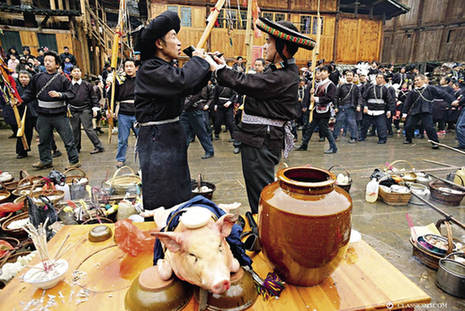Wan Zhengwen: Champion of the Miao Wooden Drum Dance
 |
|
Wan Zhengwen (left) toasts a fellow villager in celebration of the Wooden Drum Dance. |
From Act of Worship to Popular Entertainment
Before the 1980s, the Wooden Drum Dance in Fanpai Village was performed every seven years (in other regions it was performed every 13 years) during the ancestor worship ritual. After the ritual the sacred drum would be packed away for safekeeping. From the end of one rite to the beginning of the next, no one was allowed to beat the drum or perform the dance.
These restrictions meant that passing on the skills of the Wooden Drum Dance was not easy. First, because it was only performed every seven years, the dance couldn’t be taught at any time in everyday life. Second, during the dance, performers were not allowed to talk, so if people truly wanted to learn, they had to do so by observing. They had to imitate the movements and remember the rhythm of the drumbeat. The most difficult thing was learning how to play the drums, as the beat features many changes in rhythm and pitch. Only those who had musical talent and paid close attention would finally master the skill. This learning method has made it difficult for the Wooden Drum Dance to be passed on to future generations – but not impossible.
“Under the influence of my older relatives, I came to enjoy singing and dancing as a child. When I saw people dancing, I would watch carefully and try to remember every movement I saw. I would practice those movements by myself and often ask my parents for help if I had questions. My village was very poor then; everyone was busy farming and working and few activities were held during minor holidays. So I had limited opportunities to learn the dance and really looked forward to every grand festival,” Wan recalled.
When Wan was seven or eight years old, his talent was spotted by a senior drummer in the village. The teacher taught Wan the finer points about dancing, drumming and playing the lusheng. As China prospered under the reform and opening-up policies, the lives of villagers saw much improvement. People had more time to celebrate festivals with singing and dancing. The older generation started to teach the younger generation about traditional arts and culture. Wan continued to study with the senior dancers of the village and kept up his independent practicing, quickly mastering the skills of the Wooden Drum Dance.
In 1982, Wan’s passion for the traditional dance had a firm hold on his life. Together with over 10 friends who shared the same ambitions, Wan formed and led a Wooden Drum Dance troupe. The dance was no longer performed every seven years. New rules allowed it to become an integral part of many important festivals.
